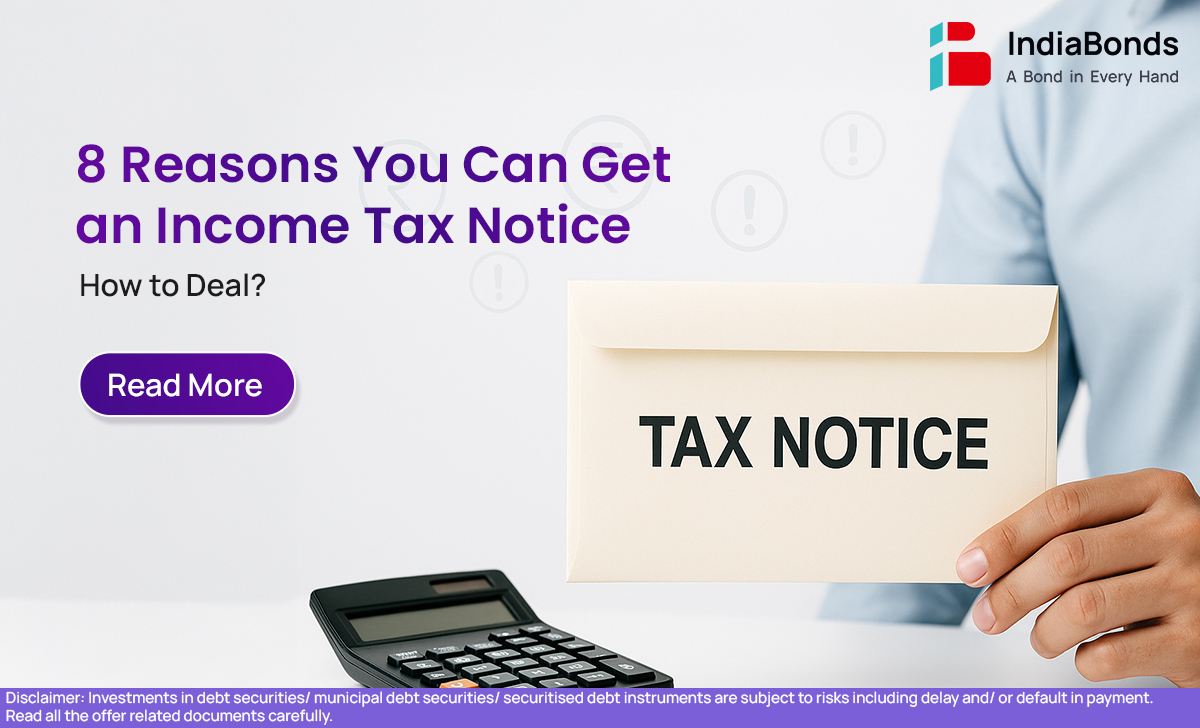8 Reasons You Can Get an Income Tax Notice – How to Deal

Introduction
An income tax notice is not a panic button. It’s simply the department saying, “We found something, please confirm or correct.” Most Indians who file on time and keep basic records can close it online in a few clicks.
Reasons For Which You Can Receive an Income Tax Notice
Below are the most common triggers. Think of them as red flags the system spots while matching your data with Form 26AS/AIS, bank reports and your return.
1) Inaccurate information on assets or income in the return
If a salaried person in Pune forgets to report bank interest or rent from a flat in Nagpur, the system catches it. The result can be a 143(1)(a) communication proposing an adjustment, or a follow-up income tax notice asking for proof.
2) Discrepancies between actual income and declared income
Say a freelancer shows ₹8 lakh income, but TDS entries in AIS suggest receipts closer to ₹12 lakh. Such gaps invite a query to explain invoices, credit notes or timing differences. Clear working papers usually close it quickly.
3) Sudden jumps in investments, high-value transactions or income
Large cash deposits, hefty credit card payments or buying mutual funds suddenly far above earlier years can trigger a verification call. A bonus year, sale of ancestral land, or a one-time gift from parents are all fine—just keep documents to back the source.
4) TDS mismatch or wrong claim
A very common cause. Example: a Mumbai employee claims TDS from two employers but only one has reported it correctly. When Form 26AS/AIS doesn’t match the claim in the ITR, a notice asks for clarification or revised figures. Rectifying the employer’s TDS return (Form 24Q/26Q) usually solves it.
5) Case picked for review and evaluation
Sometimes returns are selected for limited scrutiny—purely risk-based. You may be asked to upload rent receipts, housing loan interest certificates, capital gains workings or medical insurance proofs. Treat it like a checklist, not a courtroom.
6) Delayed return filing
Missing the due date or filing an incomplete return can bring an income tax notice. If the return is defective under section 139(9), the portal asks you to fix missing data (for example, not attaching the correct ITR schedule for capital gains) within the stated time.
7) Refund adjusted against pending tax dues
If you have an old outstanding demand—maybe a small self-assessment tax missed a few years back—your new refund can be adjusted. You’ll receive an income tax notice informing you of the set-off. You can agree or contest it with reasons on the portal.
8) Reopening related to earlier years of possible under-reporting
Where the department believes income escaped assessment, it may issue a reassessment notice under the Income Tax Act section 148. For example, sale of property in 2021 not reported in the ITR may come up later when registry data syncs. Section 148 is serious but still process-driven: explain, submit proofs, and file the return for that year if asked. Many genuine cases close with proper documentation. (This phrase “income tax act section 148” will appear in your notice.)
Quick note on wording you may see: some letters call it “income tax notice 143 1 a” (commonly written as 143(1)(a)). It’s usually a proposed adjustment, not a penalty.
Things To Do After Receiving an Income Tax Notice
- Read the section and deadline. Is it 143(1)(a), 139(9), 148, or something else? Note the response window (often 15–30 days).
- Log in to the e-filing portal and open the notice under “View Notices/Orders.” The response option sits right there.
- Match data with AIS/26AS. Check TDS, interest, dividends, property sale values and broker statements.
- Collect proofs. Salary slips, Form 16, rent agreement, 80C/80D receipts, capital gains statements, bank statements, sale deeds—attach only what’s relevant.
- Respond clearly, in simple points. If you agree, file a revised/updated return or pay the demand. If you disagree, explain why and upload support.
- Track acknowledgement. The portal shows status updates. Keep the final order copy.
- Seek a CA when needed. For complex issues like Income Tax Act section 148 or multiple-year capital gains, a professional reply helps.
Conclusion
Most income tax notices are routine data-checks. Respond within time, keep numbers consistent with AIS/26AS, and use the portal. With a neat explanation, even a 143(1)(a) or a section 148 query can be closed without drama.
FAQ
How to deal with an income tax notice?
Stay calm, read the section and last date, and reply on the e-filing portal. Match your return with AIS/26AS, attach only relevant proofs, and submit a clear response. If you accept the difference, revise the return or pay the amount and close it.
Can I ignore an income tax notice?
No. Ignoring can lead to interest, penalties, or best-judgment assessment. Even if you think it’s a mistake, acknowledge the notice and reply with facts. The portal has a simple workflow to agree or disagree.
How do I respond to an income tax show-cause notice?
Address every point listed. Use numbered answers, attach documents right under the respective point (for example, rent receipts under HRA, sale deed under capital gains), and end with a short summary. Submit within the deadline and keep the acknowledgement.
How do I solve my income tax demand notice?
First, verify the demand with AIS/26AS and your ITR. If correct, pay it online and submit the challan details on the portal. If incorrect (say, TDS not reflected), raise a disagreement with reasons and supporting documents. Many demands get reduced once mismatches are fixed.
Disclaimer : Investments in debt securities/ municipal debt securities/ securitised debt instruments are subject to risks including delay and/ or default in payment. Read all the offer related documents carefully.
































